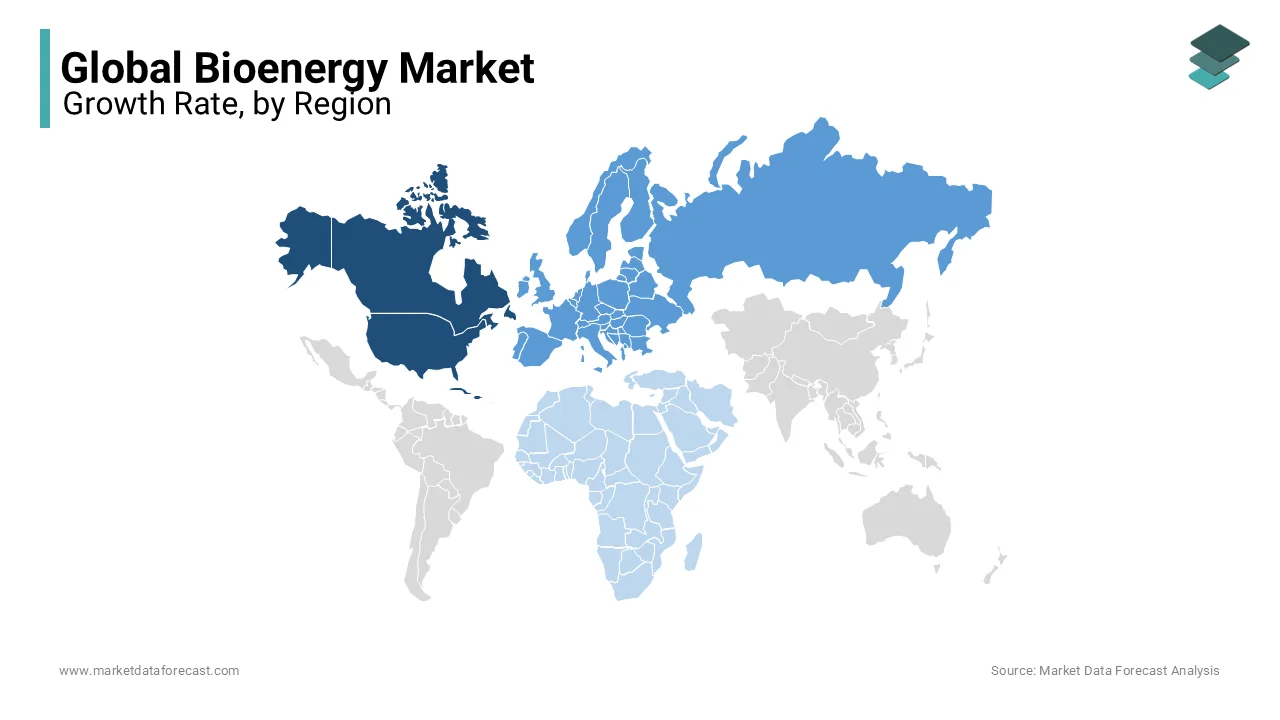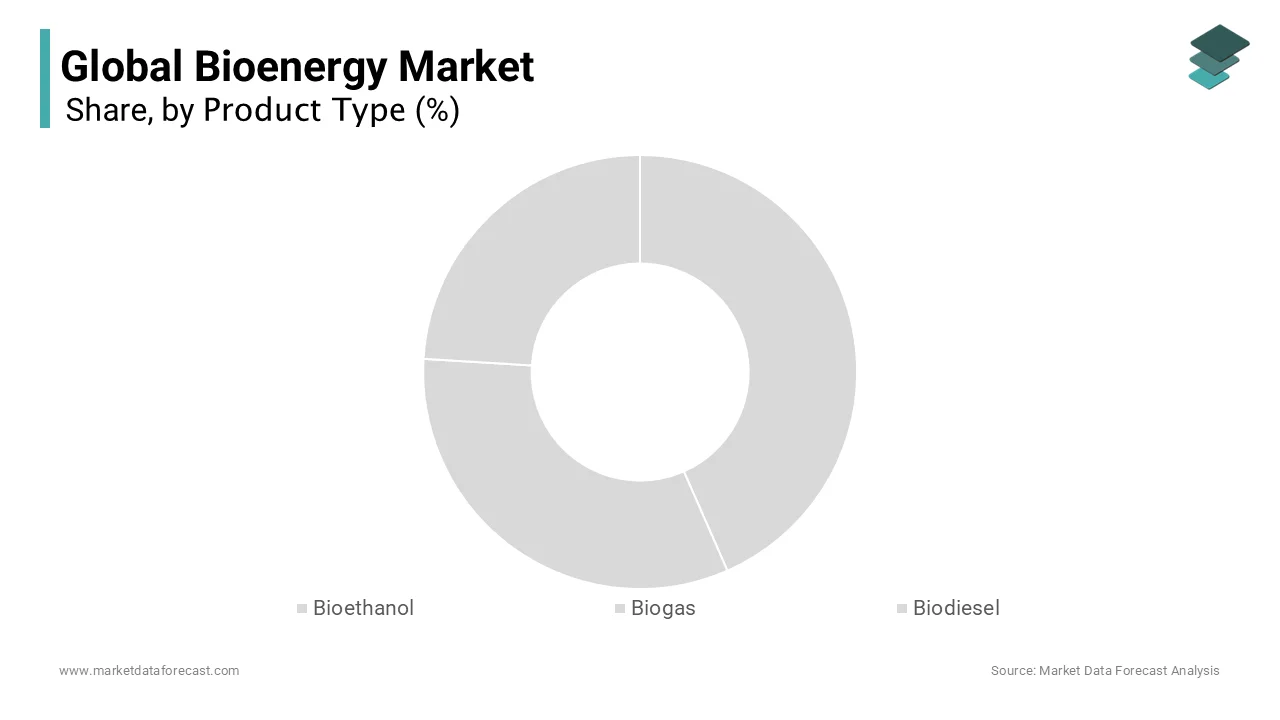Global Bioenergy Market Research Report - Segmentation By Product Type (Bioethanol, Biogas, Biodiesel and Others), By Application (Cooking, Off-Grid Electricity Supply, Transportation and Others), and Region (North America, Europe, Asia Pacific, Latin America, and Middle East & Africa) - Industry Analysis (2024 to 2032)
Global Bioenergy Market Size (2024-2032):
The size of the global bioenergy market was worth USD 123.79 billion in 2023. The global market is anticipated to grow at a CAGR of 8.75% from 2024 to 2032 and be worth USD 263.36 billion by 2032 from USD 134.62 billion in 2024.

Current Scenario of the Global Bioenergy Market
Bioenergy refers to a renewable energy source made from materials derived from biological sources. The growing concern for the environment and energy security is one of the main factors driving the expansion of the global bioenergy market. Since fossil fuels are minimal and energy is derived from fossil fuels, several countries are looking for alternatives to conventional energy sources. Bioenergy is gaining importance as one of the fastest-growing alternatives to traditional energy sources, helping to expand the energy mix and reduce dependency on worldwide oil markets. Bioenergy benefits countries with little or no reserves by reducing their dependence on imported crude oil. Furthermore, as bioenergy is derived from local raw materials, governments offer incentives for producers and farmers to generate biomass raw material, promoting bioenergy production. The global bioenergy market is experiencing enormous development, providing its users with the most reliable and advanced solutions. Bioenergy is a renewable energy source composed of materials derived from natural/biological sources. For example, biomass is a type of bioenergy that can include wood, manure, waste, sugar cane, straw, and many similar products. Worldwide, an energy crisis is being experienced; therefore, efforts are being made to use various types of bioenergetic solutions to protect the current situation.
MARKET TRENDS
Since the world is under pressure from a growing energy crisis, you must consider different types of bioenergy solutions to save the day. Rising oil prices, finite and depleting resources, and growing environmental concerns are some of the compelling reasons driving the expansion of the global bioenergy market. Furthermore, the promotion of bioenergy through the Kyoto Protocol has also led to a rapid expansion of this market in most of the signatory countries. The energy extracted from these materials is less harmful to the environment, which makes them attractive to investors and users.
MARKET DRIVERS
The growing need for energy worldwide to keep up with escalated manufacturing and sprawling urbanization has caused a massive loss, causing many countries to opt for different power generation options.
The escalating pressure on world leaders to reduce the carbon footprint and the toxic amount of greenhouse gases is also forcing countries around the world, especially developing and developed countries, to take the alternative seriously. In view of these social, environmental, and political pressures, the global bioenergy market is predicted to grow at a significant rate. Another major expansion in the worldwide bioenergy market is the alarming crisis in energy security measures. The transportation sector is the backbone of any financial system, which depends mainly on oil, which makes it extremely vulnerable to any type of variation in the price of oil. Current economic conditions are completely reliant on renewable energy sources to provide long-term energy protection by reducing their dependence on any other country to develop their financial expansion. Therefore, sustainable green projects launched by some governments should encourage the practice of bioenergy in many sectors.
MARKET RESTRAINTS
Several environmentalists are also opposed to the idea of burning forest biomass because it generates greenhouse gas emissions.
MARKET OPPORTUNITIES
Some of the main drivers of expansion in the global bioenergy market are concerns about energy shortages and the environmental impact of carbon emissions, as well as growing fears of losing the energy independence of many governments. Another factor that adds to the changing outlook of the bioenergy market is its potential to drive rural development and open up new opportunities for the agricultural and forestry sectors. However, the biggest opportunity for the worldwide bioenergy market is the rising call for electricity around the world. Key trends in the bioenergy market, such as escalated investment in the bioenergy sectors, will also drive the expansion of the bioenergy market during the foreseen period. Globally, governments and private organizations are escalating their investments to produce biofuels through grants and special loans. This has encouraged suppliers to establish high-capacity biofuel manufacturing plants. While the bioenergy market is still in its infancy, these great business investment models will attract other suppliers and help expand the bioenergy market. Due to these factors, the bioenergy market will register a CAGR of almost 7% during the foreseen period.
MARKET CHALLENGES
As development and advancements foster the expansion of the worldwide bioenergy market, there are several hurdles that this market must overcome to make it an uncontrollable success story. The bioenergy market faces challenges in terms of assistive technology, economy, and knowledge.
REPORT COVERAGE
|
REPORT METRIC |
DETAILS |
|
Market Size Available |
2023 to 2032 |
|
Base Year |
2023 |
|
Forecast Period |
2024 to 2032 |
|
CAGR |
8.75% |
|
Segments Covered |
By Product Type, Application, and Region. |
|
Various Analyses Covered |
Global, Regional & Country Level Analysis, Segment-Level Analysis, DROC, PESTLE Analysis, Porter’s Five Forces Analysis, Competitive Landscape, Analyst Overview of Investment Opportunities |
|
Regions Covered |
North America, Europe, APAC, Latin America, Middle East & Africa |
|
Market Leaders Profiled |
Amyris, Inc., BP Biofuels, Abengoa Bioenergy, Ceres Inc., Butamax Advanced Biofuels, Enerkem, E. I. du Pont de Nemours and Company, Joule Unlimited, Gevo, Inc., LanzaTech, POET LLC, Novozymes, Solazyme Inc., Sapphire Energy, and Zeachem Inc, and Others. |
SEGMENTAL ANALYSIS
Global Bioenergy Market Analysis By Product Type
It is predicted that bioethanol and biodiesel segments will grow at a major share in the worldwide market.
REGIONAL ANALYSIS

The bioenergy market in North America is predicted to increase due to the stringent emission standards in the region. The United States of North America is predicted to lead bioethanol production in the coming years, while Germany in Europe is predicted to lead biogas production in the foreseen years. Therefore, Germany is predicted to become the world bioenergy market leader in the European bioenergy market. The European industry is predicted to grow thanks to positive subsidy programs. Escalatedcall for electricity due to population expansion have resulted in cleaner and more resourceful energy solutions in Asia-Pacific, therefore, this area is projected to experience significant expansion in the future, which will be followed closely by the Middle East. Europe was the largest bioenergy market in 2019, and the region will provide several expansion opportunities for market providers during the foreseen period. The escalating use of biodiesel in vehicles to reduce greenhouse gas emissions will significantly influence the expansion of the bioenergy market in this locale. More than 34% of the market expansion will come from Europe during the foreseen period. Germany and France are the main bioenergy markets in Europe. Market expansion in this region will be faster than market expansion in the MEA.
KEY PLAYERS IN THE GLOBAL BIOENERGY MARKET
Companies playing a prominent role in the global bioenergy market include Amyris, Inc., BP Biofuels, Abengoa Bioenergy, Ceres Inc., Butamax Advanced Biofuels, Enerkem, E. I. du Pont de Nemours and Company, Joule Unlimited, Gevo, Inc., LanzaTech, POET LLC, Novozymes, Solazyme Inc., Sapphire Energy, and Zeachem Inc, and Others.
RECENT HAPPENINGS IN THE GLOBAL BIOENERGY MARKET
- Australia launches a new bioenergy roadmap for a greener future. Australia has initiated a consultation on the development of a first national roadmap to inform the next round of investment and policy decisions in the bioenergy sector.
- The high-level worldwide forum of the Clean Energy Ministerial Conference (CEM) officially launched the new Biofuture platform initiative. The scope of work, to be implemented in close collaboration with the private sector, will increase international ambition and promote the production, trade, and use of sustainable bioenergy and biomaterials worldwide, through policies.
DETAILED SEGMENTATION OF THE GLOBAL BIOENERGY MARKET INCLUDED IN THIS REPORT
This research report on the global bioenergy market has been segmented and sub-segmented based on product type, application, and region.
By Product Type
- Bioethanol
- Biogas
- Biodiesel
- Others
By Application
- Cooking
- Off-Grid Electricity Supply
- Transportation
- Others
By Region
- North America
- Europe
- Asia Pacific
- Latin America
- Middle East & Africa
Frequently Asked Questions
1. What is the Bioenergy Market growth rate during the projection period?
The Global Bioenergy Market is expected to grow with a CAGR of 8.75% between 2024-2032.
2. What can be the total Digital Water Solutions Market value?
The Global Bioenergy Market size is expected to reach a revised size of USD 263.36 billion by 2032.
3. Name any three Bioenergy Market key players?
BP Biofuels, Abengoa Bioenergy, and Ceres Inc are the three Digital Water Solutions Market key players.
Related Reports
Access the study in MULTIPLE FORMATS
Purchase options starting from
$ 2500
Didn’t find what you’re looking for?
TALK TO OUR ANALYST TEAM
Need something within your budget?
NO WORRIES! WE GOT YOU COVERED!
Call us on: +1 888 702 9696 (U.S Toll Free)
Write to us: sales@marketdataforecast.com
